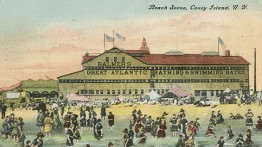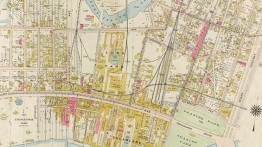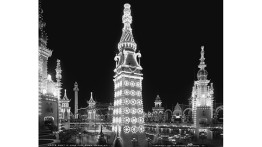NEW YORK CITY BEACHES Coney Island & Rockaway at the Turn of the 20th Century
Fri, Oct 27, 2017 6pm - Sat, Nov 11, 2017 9am
This exhibition features postcards selected from the Architecture Archive’s Joseph Covino New York City Postcard Collection. Dating from the late 19th to mid-20th century, the collection is among the largest of its kind. Its nearly 3,800 postcards were donated to the Archive between 1999 and 2003 by Joseph Covino, an avid postcard collector. Most of the postcards document New York City’s built environment and infrastructure, including many no-longer-extant buildings, interiors, businesses and public spaces. As such, the collection records a city in constant flux, capturing several decades of urban development through photographs and illustrations. It includes a broad range of subjects and thousands of individual structures and sites across all five boroughs, from the City’s piers, airports, subways and armories to its public parks, aquariums, monuments and places of recreation.
The postcards on display document the astonishing transformation of the City’s southern coastline during the last decades of the 19th century. At Coney Island, an influx of private capital, transportation infrastructure and unfettered commercial development rapidly converted the Island’s pastoral landscape, still sparsely inhabited after the Civil War, to “a laboratory of the new mass culture where the raw embryonic elements of physical sensation and mechanical invention were tested.” (Immerso, Michael. Coney Island: The People’s Playground) Between 1875 and 1881 alone, the equivalent of over 400 million dollars was invested in the creation of Frederick Olmstead’s Ocean Parkway, linking Prospect Park to a newly constructed grand Concourse along the oceanfront; the parallel development of four railroad lines connecting Coney Island to Brooklyn and Manhattan; the construction of two massive ocean piers (the Iron Pier and the New Iron Pier) which serviced steamboats, each capable of ferrying up to 40,000 passengers daily from Manhattan; and the proliferation of resort hotels and bathing pavilions along the newly created Manhattan Beach resort on the Island’s east end.
October 27 – November 10, 2017
On view in the 3rd Floor Hallway Gallery of The Foundation Building.
Open to current students, faculty and staff.
Located at 7 East 7th Street, between Third and Fourth Avenues
Curated by Christopher Dierks
Located at 7 East 7th Street, between Third and Fourth Avenues








